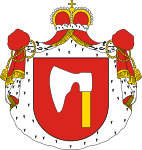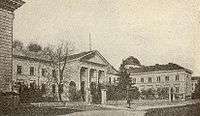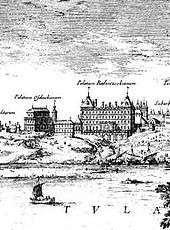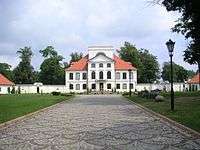House of Ossoliński

Ossoliński (plural: Ossolińscy) is the surname of a Polish szlachta (nobility) family. Because Polish adjectives have different forms for the genders, Ossolińska is the form for a female family member
History
The Ossolińskis were a magnate family. They appeared in the historical annals at the beginning of the 14th century. The family originated from Ossolin in Lesser Poland. The progenitor of the family was Jan z Ossolina, son of Great Marshal of the Crown and castellan of Kraków Nawoja z Tęczyna. Jan was the main heir of the property that Nawoja left after his death. Due to the tradition in medieval Poland, he started to use the surname derived from the main family seat. Grand Chancellor of the Crown Jerzy Ossoliński was granted a hereditary princely title by Pope Urban VIII in 1633. He also received a similar title, Reichsfürst, from the Emperor Ferdinand II in 1634. Another title was granted to Jerzy's cousin Franciszek Maksymilian Ossoliński by Louis XV, King of France, in 1736. Both titles became extinct in 1790. Jerzy's famous library that he located in Lwów, the "Ossolineum", initiated the beginning of the Ossoliński Institute, which was founded by Józef Maksymilian Ossoliński in 1817.
Coat of arms and motto
The Ossoliński family used the "Topór" arms.
The Ossolinski's castle was reputedly the biggest in Europe prior to the building of Versailles (see James Michener's book Poland). Its name was 'Krzyżtopór' ("The Battle Axe of The Cross").
The descendants are represented in North Western England through Count Boris Ossolinski, whose Jackson heiress bride is remembered in England as Countess Mary Ossalinsky.
-

Princely House of Ossoliński (1633)
-

Counts Ossoliński (1785)
-
Coat of Arms of the Ossoliński family on the St. Antoni Padewski Church in Warsaw
Members
- Jan Zbigniew Ossoliński (1555–1628), Podkomorzy, voivode
- Krzysztof Ossoliński (1587–1645) Podkomorzy, Podstoli, voivode
- Jerzy Ossoliński (1595–1650), Great Crown Chancellor
- Helena Tekla Ossolińska (?-1687), was married to Aleksander Michał Lubomirski
- Franciszek Maksymilian Ossoliński (1676–1756) Grand Chancellor
- Anna Teresa Ossolińska (?-1810), was married to Stanisław Potocki
- Józef Maksymilian Ossoliński (1748–1826), founder of the Ossoliński Institute
- Józef Kajetan Ossoliński (1758–1834), castellan, senator
Palaces
-

The Ossoliński Institute in Lwów
-
The Ossoliński Institute in Lwów
-

Castle in Ossolin, 1794
-

Castle in Krzyżtopór
-

Palace of Jerzy Ossoliński in Warsaw (on the left)
-

Ossoliński Palace in w Rudka
-

Palace in Sterdyń
-
Palace in Rejowiec
-

The Hetman Tenement House in Kraków
See also
Bibliography
- Andrzej Przybyszewski, Ossolińscy herbu Topór, Radomyśl Wielki, 2009, ISBN 978-83-927999-2-4
.jpg)